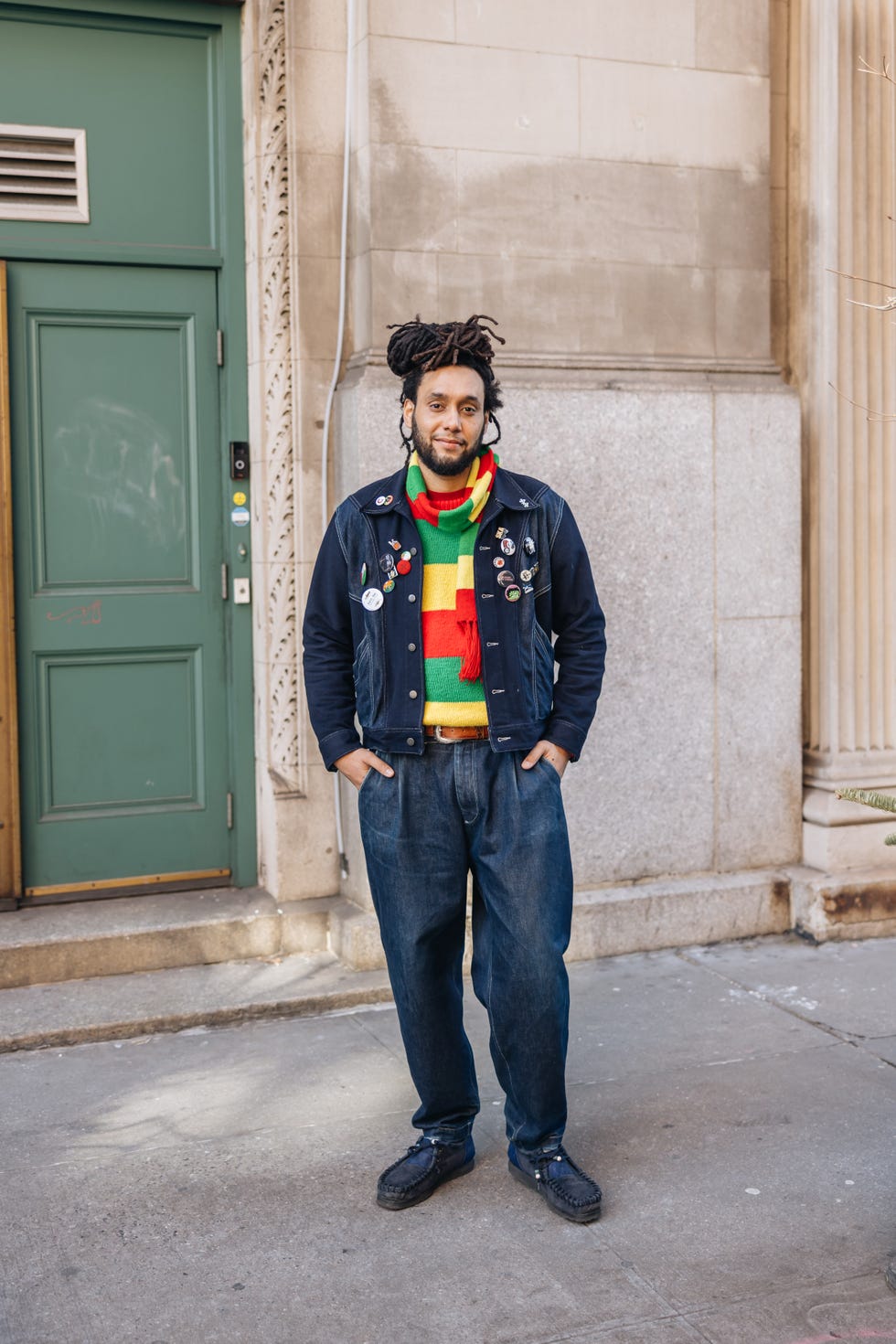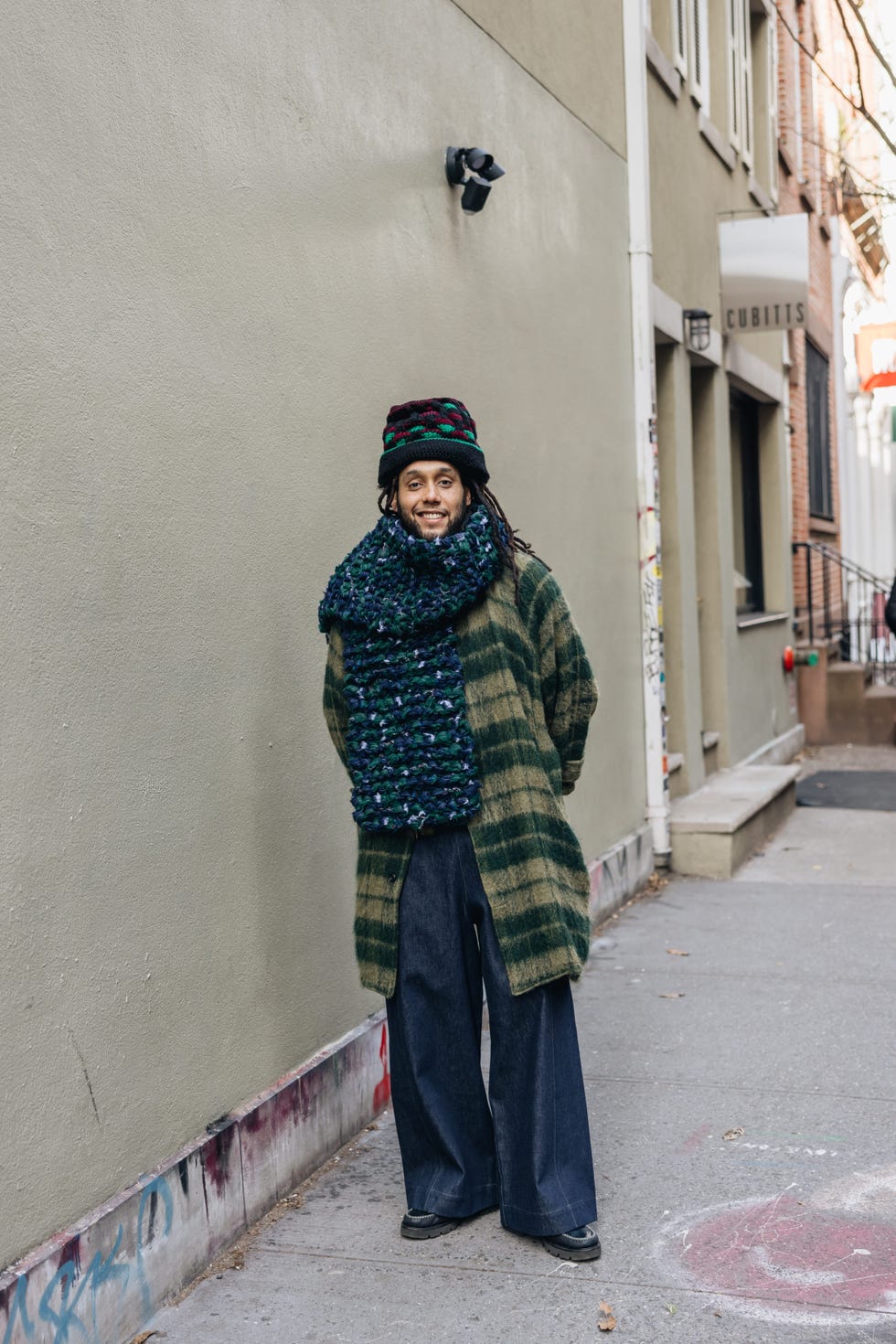Five Fits With: Culture-Mixing British Designer Nicholas Daley

Nicholas Daley, founder and creative director of the eponymous London-based label, is fascinated by the intersection of music, culture, and fashion. He comes by it naturally. Born to a Scottish mother and a Jamaican father, finding connections between seemingly disparate backgrounds and traditions has always been a part of his life. He honed that perspective at the prestigious fashion school Central Saint Martins, from which he graduated in 2013, before founding his own brand in 2015. Since then, he’s won a slew of awards, been a finalist for the LVMH Prize, and expanded globally. Now, you can find his designs in stores around the world.
The fashion industry is notoriously tough, and longevity isn’t a given. Daley credits his decade-long run to maintaining a sense of self throughout. “Great style is always very personal. In an age of fashion where things are very much homogenized, having good style or having a perspective is quite challenging sometimes,” he says. “Coming up on 10 years, I think people do appreciate the things I appreciate, in various forms.”
One of those things, of course, is music. That comes from his parents. The pair ran a reggae club together in Scotland in the ‘70s and early ‘80s. “Some of the things I wear on a daily basis and have become very important iconography within my brand, are definitely from me looking to my parents and what they did,” Daley says. Below, we discuss how he fell in love with fashion and clothing, the inspiration behind his recent collections, his favorite brands beside his own, and plenty more.
Fit One
How did you first become interested in designing clothing?
Quite naturally. My mom is Scottish and my dad's Jamaican. My latest collection, “Island Ties,” and my spring collection, “Sacred Drums,” both explore my ethnicity, my cultural appreciation of both places where I'm from. On my dad's side, my grandfather was a shoemaker. My dad and a lot of my uncles—the Windrush generation that came to Britain—a lot of what they wore was suiting and very sartorial. We've got a Clarks collaboration coming out this year, and obviously Clarks has a big history in Jamaica. So naturally there have been things from throughout my upbringing in my work, whether it's looking at the Jamaican influence through suiting and tailoring, Rastafari, the colors. On my mother's side, we make kilts and we produce a lot of fabric and a lot of amazing knitwear from Scotland. And then I pull on different things from my own background. I've been drawing and creating since I was quite young. I worked at a streetwear store when I was 16, so that was Stüssy and Carhartt and various other streetwear brands I was exposed to. When I worked at this store, it was very much skating and hip-hop, the real core of it.
Fit Two
How did going to fashion school help shape your career?
Going to Saint Martin's was a great experience because it's produced some amazing designers and brands. Whether it's John Galliano or Craig Green, there’s been a whole host. And it's nice that I'm able to be part of that alumni, which has been beneficial in terms of my career. I've been blessed to have worked with some amazing stores, and I had a really interesting, educational upbringing within fashion. I spent time on Savile Row for about half a year during my studies to learn more about tailoring. I've worked with quite a few different tailors. I've worked with other British brands like Nigel Cabourn, learning a lot about vintage clothing, British manufacturing, what you need to do to be an independent brand. It's been a real mixture of different influences and impacts, but ultimately, I've always leaned on the things which truly have inspired me.
Is it important to you for people to understand your references and inspirations in each collection? How do you manage to tell those stories and balance that knowledge of what can be a pretty fickle, shallow industry?
It's quite hard. My label is my name. It's very much about me and the community I'm a part of and the cultural impact of being a British designer and coming from a mixed-race background. “How do I celebrate the cultural richness that I’ve been exposed to through my collections?” is always a big thing that I ask myself. We worked with Lyle & Scott this year, which is a 150-year-old Scottish knitwear brand. How do I change a brand’s language and DNA and create something new and fresh with my own perspective? The same with Clarks Originals and the classic Wallabee. How do I do you bring my flavor to it and honor the impact it's had on Jamaica and the world? Through these archetypes, whether it's a fabric mill or a particular shoe or a hat or a scarf, I try to break that down and recontextualize it in a way which is important or hasn't been explored.
Fit Three
Is there a disconnect between the clothes you design and the clothes you choose to wear? Do you design with yourself in mind?
I wear most of my stuff, generally. That's how I started—the fact that I either couldn't afford or couldn't find something that would fit. That's what propelled me to be like, "Well, I'll make my own trousers." Or, "I'll make my own shirt." You've got to make things that feel important to you and that you would wear. Whenever I'm designing a shoe or a collaboration or a jacket or my mainline, it's like, "Would I wear that or could I see my community wear that?" That's always the bottom line. I love wearing my own clothes and aging with them, but it's great to support other independent brands making great products.
Which brands other than your own do you respect?
I love other brands. I just got a Mantle and Evan Kinori jacket, which are two really great designers. Both of them are my friends. In America, you've got Connor McKnight, a really cool guy. In Japan, N-coming by Taiki Kato, he used to work for me and he’s an incredible designer. These are all people who I know go through very similar issues and struggles being a fashion brand in a very difficult complex market. It's important to honor that as much as possible.
Fit Four
What lessons have you learned in having your own brand and designing your own clothes?
It's my name and my vision and I'm very humbled and grateful for everyone who's been part of the journey. From when I started to now, so many people have helped along the way. The reason why it's still a thing today and still exciting people is because I'm driven to put this message out and to have as many people understand it or support it or celebrate something from it. You need to have thick skin and a tough character to be able to pull through; you just try your best to do the best you can every season and with every project, but not everything's going to go the way you want. So, how do you pick yourself back up? The community aspect is always great. Goya Gumbani, who you featured, is a really good friend of mine. We've worked on a load of projects and I love his music. How do we come through together as a creative community, within the Black community, being a Black designer? How do you find solidarity to shine more light on certain topics or notions within our community? I try to bring as much of that to the table as possible.
That's why whenever I'm in New York City, I'm seeing Alvin Armstrong or Michael Thorpe, all of these amazing Black artists, seeing different entrepreneurs and businesses along the way. I'm so happy that we've got such a great representation for the brand in Blue and Green. Naoki [Hamano] is an amazing person, Sweetu at CHCM, Million Goods in Brooklyn, and Seed, a Black-owned store in Bed-Stuy. Kristoff, who runs it, wants to help me grow and nurture the brand in America. Over the last few years New York City has been really important for my own growth. That's where I feel the next wave of influence that I can have—Stateside is where it seems to be flowing.
Fit Five
If you had to wear one outfit for the rest of your life, what would it consist of?
Good Lord. I mean, probably some sort of hand-knitted hat for sure. The one I'm wearing now, because my mom always makes me knitted hats every Christmas. Our Rebel Jacket, which is a ‘70s-inspired short jacket that I wear a lot with pin badges on it. The two-pleat or single-pleat trouser from our collection, because that piece was one of the silhouettes I did all the way back in Saint Martin's. Then the Reggae Club T-shirt—a T-shirt my parents made that’s very much a part of my family history, our family crest. Then our oversized coat, the Big Mac, which was a vintage Burberry jacket from a long time ago that I reworked with the shape and the cut and the detailing. And probably a pair of Wallabees, in particular the ones I've been working on for my Jamaican heritage and their 200-year anniversary.
esquire





